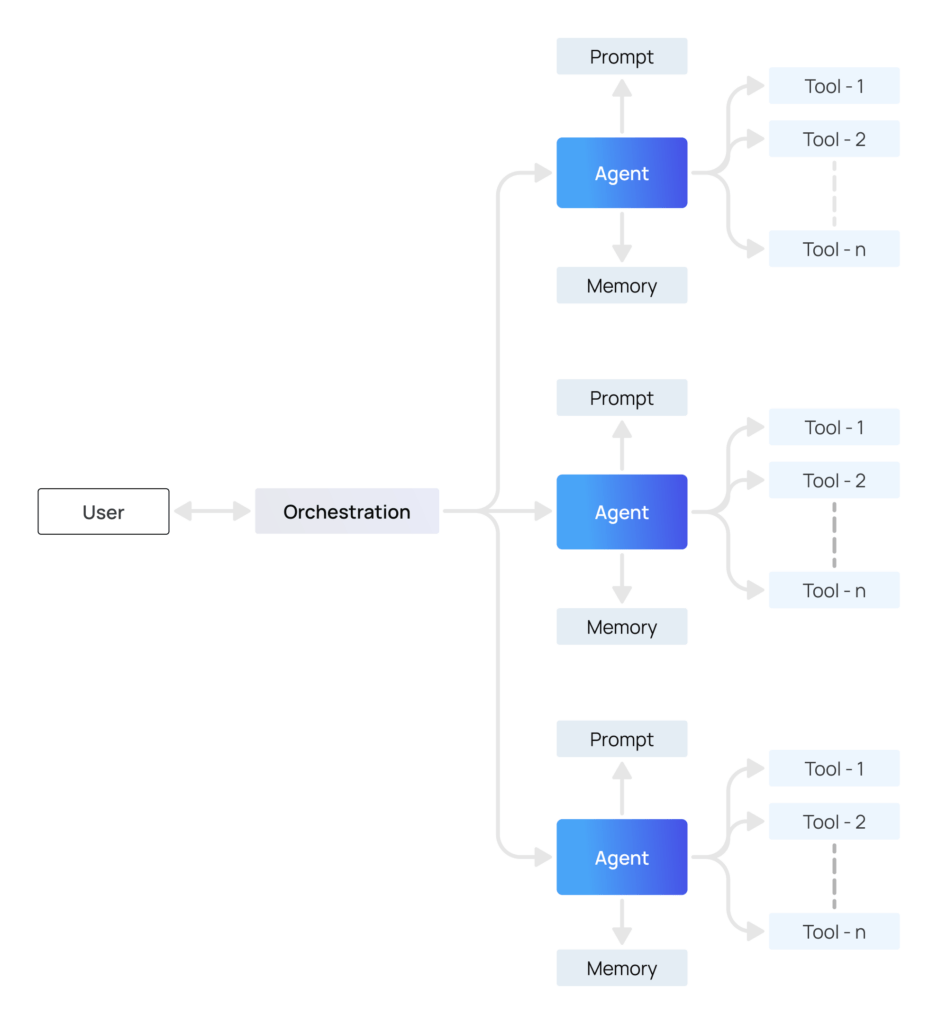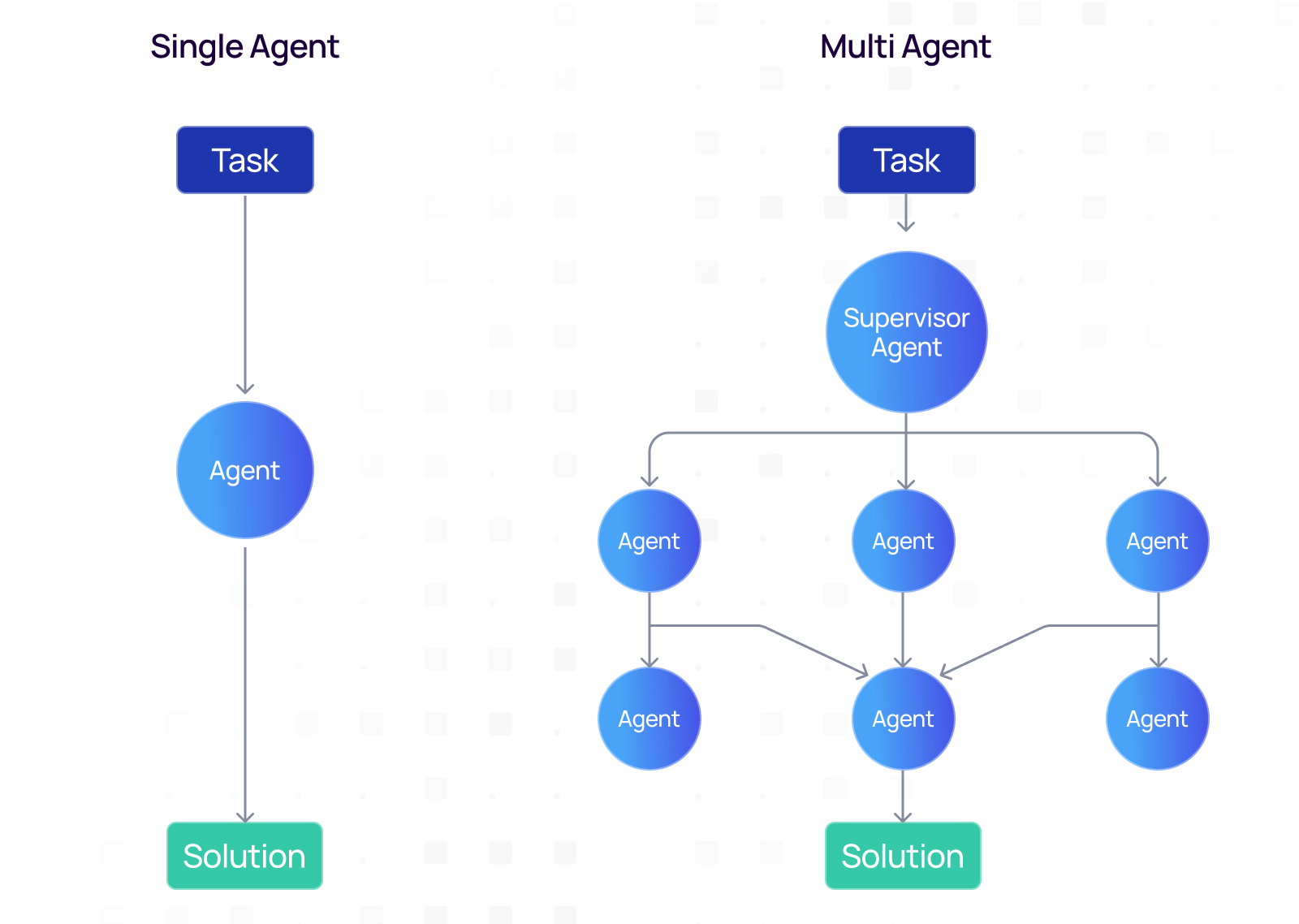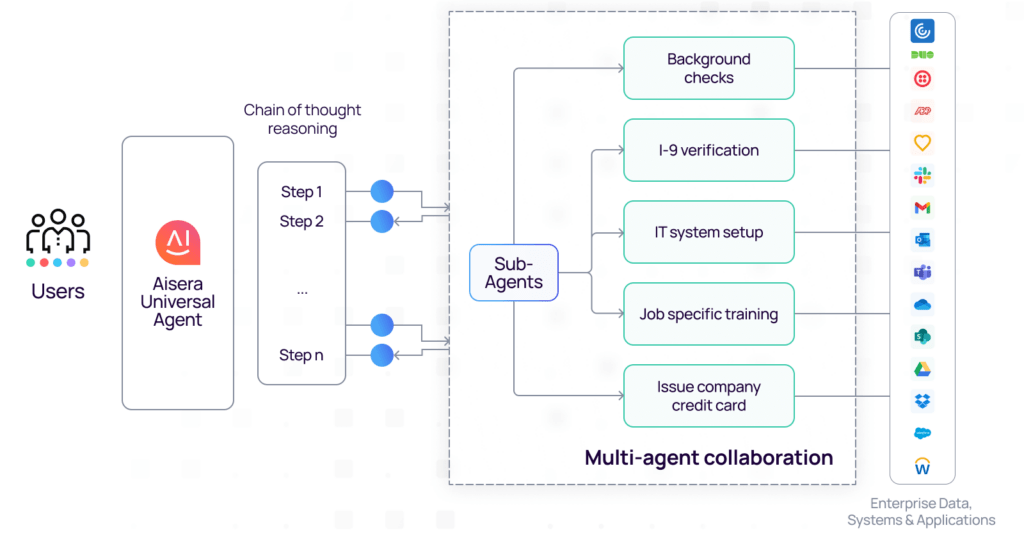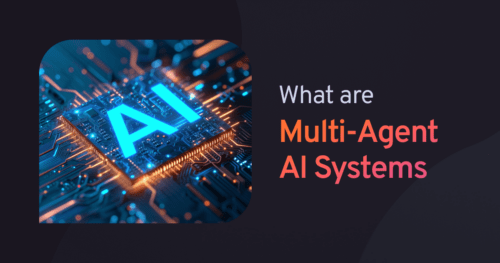What are Multi-Agent Systems?
A Multi-Agent System (MAS) is a network of autonomous, interacting AI agents that collaborate to solve problems too complex for a single model to handle. Unlike traditional automation, these systems utilize Agentic AI, artificial intelligence capable of independent reasoning and decision-making to create a unified, intelligent workforce. In a MAS architecture, specialized agents coordinate, negotiate, and execute tasks under a central orchestration layer, effectively moving enterprise AI from simple tools to adaptive problem-solvers.
At the core of this architecture is the shift from static automation to dynamic agentic orchestration.
- Autonomy: Each agent is powered by Large Language Models (LLMs) and designed to perform specific roles (e.g., a “Coder” agent or a “Researcher” agent).
- Collaboration: Agents communicate with one another to hand off tasks, critique outputs, and refine results without human intervention.
- Scalability: As workflows become more complex, the system scales by adding more specialized agents rather than retraining a single massive model.
Why Agentic AI is a Business Imperative
For C-level executives, the adoption of Agentic AI is no longer just innovation—it is a boardroom requirement. While Generative AI focuses on content creation, Agentic AI focuses on action and execution. Companies that fail to deploy multi-agent workflows risk falling behind as competitors leverage these systems to transform customer experiences, drastically reduce operational costs, and autonomously manage cross-departmental workflows in IT, HR, and Supply Chain.
The future of enterprise operations isn’t on the horizon; it is here, powered by the coordinated decision-making of Multi-Agent Systems.
The Significance of Multi-Agent AI in Autonomous Systems
Multi-agent systems are revolutionizing enterprises by enabling more adaptive, resilient, and scalable automation. Instead of relying on a single AI model to process vast amounts of data and make decisions, MAS distributes tasks across multiple specialized agents, each capable of handling distinct functions. This shift enhances efficiency, improves problem-solving capabilities, and enables more sophisticated applications, from intelligent process automation to autonomous robotics.

Fundamentals of Multi-agent Systems
A multi-agent system consists of multiple intelligent agents that can sense, learn, and act autonomously to achieve individual and collective goals. These systems are powered by artificial intelligence and have key benefits like flexibility, scalability, and robustness.
Key Components of Multi-Agent Systems
Multi-agent systems are a network of intelligent agents communicating, collaborating, and autonomously executing tasks. Building multi-agent systems is complex and requires careful planning and execution. Let’s take a look at the main components in this system of AI agents. These systems leverage AI and advanced large language models to understand context, generate insights, and automate complex tasks.
Agentic AI: How AI agents autonomously interact and learn
Unlike traditional AI models that rely on pre-programmed rules, agentic AI evolves in real-time through data and reinforcement learning.
Features:
- Autonomous decision making – AI agents analyze data and execute tasks with minimal human intervention.
- Self learning – AI agents refine processes by learning from past decisions and environmental changes.
- Inter-agent collaboration – AI agents talk to each other to divide tasks, share knowledge, and optimize outcomes.
Agentic Orchestration: Coordinating multiple AI copilots for decision-making
As you deploy multiple AI agents, the challenge shifts from individual agent or monolithic system automation to multi-agent decision making. Agentic orchestration ensures that multiple AI agents:
- Don’t conflict with each other.
- Follow the goals while adapting to real-time changes.
- Optimize business outcomes through collective intelligence.
Connecting agents within a multi-agent system is key. Effective communication and interaction between the agents improve performance and coordination.
Key Business Benefits:
- Cross-functional automation – AI copilots synchronize across IT, HR, finance, and customer support.
- Real-time adaptability – AI adjusts strategies based on changing business conditions.
- Seamless enterprise-wide AI integration – AI copilots share knowledge across departments to improve AI workflows and unified intelligence.
AI Reasoning: Enhancing problem-solving and adaptability
For AI to be autonomous, it has to process data and reason, and strategize. AI reasoning enables multi-agent systems to:
- Analyze complex business scenarios and propose solutions.
- Simulate multiple outcomes to minimize risk and maximize efficiency.
- Adapt workflows dynamically to changing customer and market demands.
Multi Agents vs Single Agent Systems
As enterprises scale agentic AI, the question arises: Do we use a single agent or multi-agent systems? While single-agent AI has its place, multi-agent enterprise AI systems are more adaptable, intelligent, and efficient, so a game changer for businesses that want to automate at scale.

Differences between Single-agent vs. Multi-agent AI
| Factors | Single-agent AI system | Multi-agent AI |
| Decision-making | Centralized, slower responses | Distributed, faster insights |
| Scalability | Limited to specific tasks; single AI agents struggle with complexity | Expands across business functions |
| Adaptability | Pre-trained, fixed rules | Learns and improves dynamically |
| Resilience | High risk of failure | Fault-tolerant and robust |
| Enterprise applications | Suited for simple automation | Ideal for complex workflows and AI-driven decision-making |
Why multi-agent AI outperforms single AI models
Traditional AI deployments often rely on single-agent AI models, which operate independently to complete tasks. These models are effective but have limitations:
- Scalability Issues – A single AI model struggles to handle complex, multi-faceted enterprise operations.
- Limited Specialization – A one-size-fits-all model lacks deep domain expertise.
- Bottlenecks in Decision-Making – Without distributed intelligence, a single AI model can become a point of failure.
The Multi-Agent Advantage
Multi-agent systems have multiple intelligent agents, each specialized for specific functions, working together seamlessly to enhance the effectiveness and clarity of the overall solution.
- Distributed Intelligence – AI agents collaborate to divide complex tasks, ensuring faster and more accurate execution.
- Scalability & Adaptability – Enterprises can add AI agents on-demand to meet evolving business needs.
- Autonomous Decision-Making – AI copilots coordinate without human intervention, increasing efficiency.
Example: A single-agent AI model in customer service may only handle FAQs, while a multi-agent system can:
- Identify customer sentiment (NLP agent)
- Retrieve relevant policies (Knowledge AI agent)
- Recommend actions to support teams (Automation agent)
By working together, multi-agent systems accelerate issue resolution, enhance customer experience, and reduce operational costs.
Use of domain-specific LLMs in distributed AI systems
To maximize the effectiveness of multi-agent AI, domain-specific LLMs (Large Language Models) play a critical role. Unlike generalized AI models, domain-specific LLMs are fine-tuned for industry-specific tasks, ensuring accuracy, compliance, and efficiency.
How Domain-Specific LLMs Improve Multi-Agent AI
- Context-Aware AI Agents – LLMs enable AI agents to interpret industry jargon, regulations, and AI workflows.
- Higher Precision & Compliance – AI-driven automation aligns with HIPAA (healthcare), SOX (finance), or GDPR (data privacy).
- Industry-Specific Decision-Making – AI agents leverage LLMs to provide relevant, real-time insights.
Impact of machine learning on autonomous multi-agent interactions
Multi-agent systems continuously leverage machine learning (ML) to improve collaboration, efficiency, and accuracy. Multiple interacting intelligent agents enable the system to become more adaptive and intelligent over time.
Key AI Advancements in Multi-Agent Learning
- Reinforcement Learning – AI agents learn from feedback loops, optimizing decisions over time.
- Self-Improving AI agents – Continuous learning allows AI agents to adapt to new enterprise challenges.
- Predictive AI Coordination – AI agents anticipate business needs, automate workflows, and enhance decision-making.
Example: In supply chain management, multi-agent AI uses ML-driven predictive analytics to anticipate demand fluctuations, optimize logistics, and prevent disruptions.
How Multi-Agent AI Systems Work
Multi-agent systems function through a network of intelligent AI agents that communicate, collaborate, and autonomously make decisions. Unlike single-agent models, which operate in isolation, multi-agent systems enable distributed intelligence, ensuring higher efficiency, adaptability, and scalability.
Communication protocols and coordination mechanisms
For multi-agent systems to work, AI agents must communicate and coordinate without human intervention. This is done through structured communication protocols and coordination mechanisms so AI agents can share data, resolve conflicts, and optimize decision-making.
Agents that handle file I/O, database queries, data analysis, and visualizations can get too complex. Simplify these by having agents focus on specific domains and reducing confusion among users and developers.
Google recently announced the Agent2Agent protocol, a standardized way for AI agents to communicate, regardless of their underlying implementation. A2A protocol addresses the challenges faced during the deployment of large-scale, multi-agent systems. A2A empowers developers to build agents capable of connecting with any other agent built using the protocol and offers users the flexibility to combine agents from various providers. Critically, businesses benefit from a standardized method for managing their agents across diverse platforms and cloud environments.
Reinforcement learning for autonomous decision-making
To enhance autonomy and adaptability, multi-agent systems leverage reinforcement learning (RL)—a machine learning technique where AI agents learn through trial, error and reward-driven optimization.
How Reinforcement Learning Powers Multi-Agent AI
- Self-Learning AI Agents
- AI agents continuously refine strategies by learning from real-time interactions.
- Reduces the need for manual programming, enabling self-improving AI.
- Dynamic Problem-Solving
- AI agents analyze historical data, current conditions, and potential outcomes to make optimal decisions.
- Ensures real-time adaptability in unpredictable business environments.
- Collaborative Learning
- AI agents share insights, learning from each other’s experiences to enhance performance.
- Drives efficiency across customer service, cybersecurity, and IT automation.
Integrating foundation models for multi-agent reasoning
To support context-aware decision-making, multi-agent systems integrate foundation models and domain-specific LLMs. These models provide deep contextual understanding, reasoning capabilities, and industry-specific expertise, ensuring that AI agents operate with higher accuracy and intelligence.
How Foundation Models Enhance Multi-Agent Reasoning
- General Knowledge & Context Understanding
- Foundation models provide AI agents with a broad knowledge base, enabling them to understand language, summarize data, and extract insights.
- Domain-Specific Expertise
- Industry-focused LLMs enhance decision-making in regulated environments, ensuring compliance and precision.
- Cross-Agent Knowledge Sharing
- AI agents access shared repositories of insights, ensuring informed and cohesive enterprise automation.

Key Applications and Use Cases
AI Copilots in Enterprises: Automating workflows with multi-agent collaboration
Enterprise workflows often involve complex, multi-step processes requiring coordination between teams, systems, and AI-driven functions. Multi-agent AI enables AI copilots to collaborate autonomously, streamlining workflows across IT, HR, finance, and customer service through agentic process automation.
How Multi-Agent AI Automates Enterprise Workflows
- AI Copilots for IT Automation
- AI agents proactively identify system issues, recommend fixes, and execute resolutions without human intervention.
- Ensures reduced downtime and optimized IT service management (ITSM).
- Finance & HR Process Automation
- AI copilots handle invoice processing, payroll management, and compliance tracking, reducing manual workload.
- Automates financial forecasting and reporting, ensuring real-time accuracy.
- Customer Service Enhancement
- AI agents collaborate to understand customer queries, retrieve data, and personalize responses, improving CSAT scores.
- AI copilots integrate with CRM systems to provide real-time recommendations to sales and support teams.
Autonomous Robotics: Swarm intelligence in robotics and logistics
A multi-agent system is a game-changer in robotics and logistics, where multiple autonomous intelligent systems must coordinate in real-time to optimize efficiency, safety, and performance.
In robotics and logistics, multi-agent methodologies assign specialized roles to AI agents, enabling them to work collaboratively to optimize complex workflows and adapt in real time.
How Multi-Agent AI Powers Robotics & Logistics
- Warehouse Automation
- AI-powered robots work together to manage inventory, sort packages, and fulfill orders, minimizing human intervention.
- Reinforcement learning enables continuous adaptation to shifting demand and operational constraints.
- Autonomous Fleet Coordination
- AI agents dynamically coordinate delivery routes, manage traffic flow, and optimize fuel usage, cutting costs and improving efficiency.
- Real-time data sharing across agents ensures faster, more accurate deliveries.
- Manufacturing AI Agents
- Multi-agent systems oversee production lines, maintaining quality control and enabling predictive maintenance.
- AI copilots adjust workflows dynamically based on real-time demand, supply chain inputs, and performance metrics.
Financial Forecasting: AI-driven machine learning
Multi-agent AI revolutionizes financial forecasting, enabling institutions to make real-time, data-driven investment decisions while mitigating risk.
How Multi-Agent AI Transforms Financial Forecasting
- AI-Powered Market Predictions
- AI agents and predictive AI analyze historical data, economic trends, and real-time market signals to predict investment opportunities.
- Ensures higher accuracy and reduced volatility in financial planning.
- Fraud Detection & Risk Management
- AI agents collaborate to detect anomalies, flag fraudulent transactions, and enforce compliance measures in real time.
- Financial institutions use reinforcement learning to enhance fraud detection algorithms dynamically.
- Portfolio Optimization with AI Copilots
- AI copilots adjust investment strategies based on real-time market fluctuations and investor preferences.
- A multi-agent system ensures automated portfolio rebalancing, improving returns while minimizing risk.
Multi-Agent AI in Enterprise Solutions
Today’s enterprises need AI systems that can run autonomously, learn continuously, and adapt to changing environments. Multi-agent AI delivers:
- Enterprise Automation – AI copilots IT, customer service, finance, and HR, reducing costs and human workload.
- Better Decision Making – AI agents analyse big data in real time, making faster and smarter business decisions.
- Across Industries – From healthcare to finance to logistics to manufacturing, multi-agent AI is changing how businesses work.
Agents work together to achieve the overall system goals, so learning and decision-making are key.
Companies that deploy multi-agent AI get more efficiency, more agility, and AI-driven innovation, and become leaders in their industry.
How Agentic Orchestration Enhances Automation and Efficiency
At the heart of multi-agent systems is agentic orchestration—the ability to coordinate multiple AI agents for seamless automation and intelligent decision-making. Unlike traditional automation, which relies on pre-defined rules, agentic AI enables dynamic task delegation and cross-agent collaboration.
- Autonomous AI Copilots: AI agents learn, adapt and decide in real-time, minimal human intervention.
- Intelligent Workflow Automation: AI copilots automate business processes, resolve IT incidents and enhance customer interactions.
- End-to-End Decision Support: AI-powered insights drive data-driven strategies, risk management and market intelligence.
As enterprises grow, multi-agent AI ensures automation remains agile, adaptive and continuously improving. Scaling agentic AI unlocks new levels of efficiency and business intelligence.
The Future of AI Governance, Ethics, and Innovation in Multi-Agent Frameworks
As multi-agent AI adoption accelerates, enterprises must prioritize AI governance, ethical AI, and responsible innovation.
AI Governance & Ethics Considerations
- Transparency & Explainability – Enterprises must ensure AI decision making is interpretable and auditable, minimize bias, and regulatory risks.
- Compliance & Security – Agentic AI security must comply with industry regulations (e.g., HIPAA, GDPR, SOX) and secure enterprise data.
- Human-AI Collaboration – AI systems should augment human capabilities, build trust and accountability in AI-driven decisions.
The Way Forward: AI-First Innovation
- Hyperautomation – AI copilots will automate complex business operations end-to-end.
- Industry-specific AI Systems – Domain-specific LLMs will enhance contextual intelligence, making AI more precise and effective.
- Self-Learning AI Ecosystems – Multi-agent AI will drive continuous learning, enterprises will stay ahead of market shifts.
In this video, Rahul Guha, VP of Product Management at Aisera, explains how Agentic AI systems help enterprises like Adobe and Aramark achieve up to 80% auto-resolution rates.
Coordination Complexity in Multi-Agent Systems (Challenges)
Coordination complexity in multi-agent systems is the difficulty of getting multiple agents to work together to achieve a common goal. This gets harder as the number of agents or the task complexity increases and often results in conflicting goals, communication breakdowns, and reduced system performance.
To manage coordination complexity, researchers have developed various techniques, including multi-agent reinforcement learning and decentralized control. These allow agents to learn, adapt and make decisions based on their own objectives while working towards collective outcomes. By using these techniques, developers can create more efficient, effective and scalable multi-agent systems.
But designing and developing multi-agent systems is complex, especially in dynamic environments like supply chain management and transportation systems.
Solving these challenges requires specialized tools and approaches, including large language models and multi-agent reinforcement learning. And successful implementation requires a deep understanding of artificial intelligence, distributed systems, and software agents, and the ability to analyze and resolve complex coordination problems.
Conclusion: The Future of Multi-Agent Systems in Enterprise AI
Multi-agent systems are changing the way we approach automation, decision making, and scalability. By using coordinated AI agents that communicate, learn, and adapt autonomously, businesses can be more efficient, simplify complex workflows, and deliver better customer and employee experiences. Multi-agent AI is not just a technology upgrade but a business imperative for companies that want to stay relevant in a rapidly changing digital world.
As multi-agent systems evolve, their applications will expand across industries driven by advances in AI reasoning, agentic orchestration, and reinforcement learning. Companies that invest in multi-agent AI today will be better equipped to handle the complexities of tomorrow’s business environment, be more productive, resilient, and innovative. The future of enterprise intelligence is multi-agent AI.
Aisera provides a smooth path to unlocking new capabilities and the full potential of autonomous multi-agent systems. Book a custom AI demo to experience the future of AI with Aisera today!


